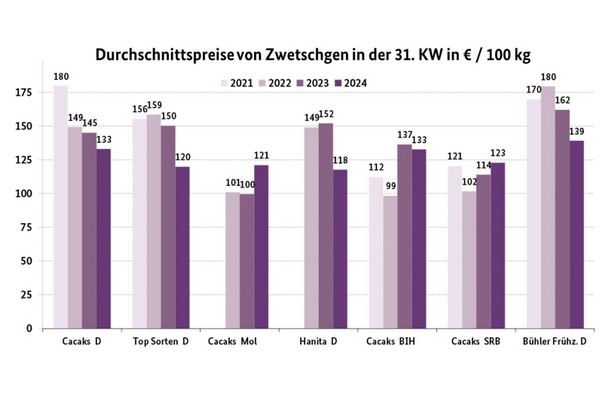Domestic offerings dominated the plum sector, with various top varieties and Cacaks varieties forming the basis of the range. According to BLE, the presence of Bühler Frühzwetschge increased, while that of Katinka decreased. New additions to the range were Ersinger Frühzwetschge, Fellenberg and Auerbacher. The transition from Lepotica to Stanley began in the Eastern European supply, which was already being supplied in abundance from Bosnia and Herzegovina.

The first Stanley was also delivered from the Republic of Moldova. Batches from France and Italy supplemented the supply. In general, the quality of the fruit was not consistently convincing. In terms of flavour, the domestic batches in particular often left something to be desired. The bottom line was that a wide price range was established on some markets, as exclusive products were sometimes in short supply. Italian and Spanish plums predominated, with French products rounding out the range. In Frankfurt, the first Aprimira plums were available at €17.50 per 5 kg crate and Bellamira at €2.50 per kg. In Cologne, the first domestic fruit at €5 per kg generated hardly any demand.
Apples
New Zealand Braeburn, Royal Gala and Jazz predominated. From Chile, Pink Lady and Royal Gala were the main varieties. South Africa mainly sent Braeburn, followed by Granny Smith and Pink Lady. Imports from overseas obviously predominated. Among the European articles, the relevance of early apples increased.
Pears
The European season picked up speed: Italian deliveries in particular intensified. Carmen and Santa Maria gained noticeably in importance. Limonera from Spain and Dr Jules Guyot from France also played a somewhat more important role than before. Shipments of Turkish Santa Maria also increased.
Grapes
The range was led by Italian deliveries, with Victoria and Black Magic in particular being available. However, Cotton Candy, Crimson Seedless and Red Globe also attracted attention. The first Italia are due to arrive in week 32 and will further expand the product range.
Strawberries
The campaign is already in the home straight: Availability was limited, demand decreased, and the quality of the fruit was no longer convincing. Distributors were often forced to reduce their previous prices, if they did not want to increase their stocks.
Apricots
French and Spanish batches predominated over Italian ones. Domestic batches supplemented the market, as did imports from the Republic of Moldova and Poland. Sugared apricots imported from Turkey were relatively popular and could generally be sold without any problems.
Cherries
The season came to an end: the availability of domestic and Turkish supplies was clearly dwindling. Belgian, Dutch and Polish fruit no longer played a major role either. Nevertheless, demand was satisfied without difficulty.
Peaches/nectarines
Spanish deliveries dominated over Italian shipments. Goods from Turkey, France and Greece completed the picture. Availability had not changed significantly. Although the summer weather had increased the demand, the holidays were noticeable in this sector as well.
Lemons
The Spanish Verna season was slowly coming to an end, with batches having already disappeared from some markets. Marketers were able to take advantage of this in some places and increase their demands for the South African Eureka.
Bananas
Business continued, without any major highlights. Sales possibilities dropped, but traders had adjusted their supply to the reduced demand. As a result, there were no fundamental changes as far as prices went.
Cauliflowers
Domestic supplies dominated and were monopolised at certain points. Belgian and Dutch batches were also available at some markets; however, the Dutch items were quite small in some places and therefore difficult to sell, even with discounts.
Lettuce
Iceberg lettuce came from Germany, the Netherlands and Spain, lettuce from Germany, Belgium and the Netherlands. In the case of coloured lettuce, only domestic goods were available. Overall, business was fairly subdued. In Cologne, availability was generally too plentiful, which is why prices often fell.
Cucumbers
The assortment of gherkins consisted of domestic, Belgian and Dutch offerings. In Frankfurt, there were also a few Spanish items in the 350/400 g size, packed in 15 pieces and offered at favourable prices. Overall, availability was slightly limited.
Tomatoes
Dutch and Belgian shipments predominated. Deliveries from Italy, Poland and Germany only played a minor role. The availability was too extensive, and sales options were limited. Favourable conditions had to be introduced if larger stocks were to be avoided.
Sweet peppers
Dutch, Belgian and Turkish, and occasionally also Spanish and Polish batches were available. Domestic batches were only available to a limited extent and were relatively expensive. In general, business was fairly slow.
Source: BLE
